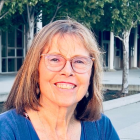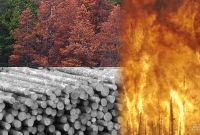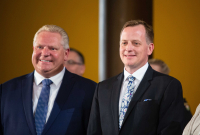Support strong Canadian climate journalism for 2025
"What is keeping you awake at night?"
The questioner was a young climate campaigner with a difference.
Flossie Baker has been trained how to listen. She was trying to learn about how lives are lived, what worries ordinary people, what brings meaning to a small island community very different from the place she lives in Vancouver.
Tasked by the Sierra Club BC to assist its campaign to preserve old growth forests, she had accepted as a fundamental that we are losing the argument.
Something new is needed. Fast.
But Flossie also understands the science: preserving old growth is essential to protecting watersheds, as a vital and highly efficient carbon sink, an unparalleled and irreplaceable biodiversity preserve, and as a means of decreasing the damage from a changing climate.
Like many of us, she has been convinced of the science for a long time. Put bluntly, if we continue on our current trajectory, human and other forms of life on this planet are in jeopardy.
Most of us in the environmental movement were raised to believe that reason will win the day. It seems self-evident that if we want change, we simply have to help everyone else to see reason.
We are the products of an educational system that told us we would grow wise, effective and successful if we took advice from our teachers who were part of the long arc of scientific history. Accordingly, having studied the science, read the books, changed our habits and had the nightmares which accompany an awareness of the stark realities, we concluded that it is our job to teach.
We talked about scientific consensus, doomsday scenarios and graphs shaped like hockey sticks. Then we talked about polar bears. We talked about disappearing icebergs and sea level rise. Sometimes we talked about wildfires. We carefully avoided mentioning climate change when our communities flooded, accepting that our empathy was a more valuable gift than our teaching.
Bread baskets, forests, watersheds and ocean fisheries are dying at catastrophic rates. A changing climate has already killed millions of people. Millions of others have seen their health and that of their children undermined by being rendered homeless. All of these are both physical and mental health crises.
However, we have by and large failed to talk directly about health in its more basic dimensions: about the little girl having trouble breathing because her town’s air is polluted by wild fire smoke; about rising cancer rates due to polluted air, soil, or fish; about the horror of the cholera and typhoid that accompany flooding; about the post-traumatic stress that haunts rural British Columbians after wildfires and flooding; about the personal stories of mental and physical trauma associated with the repeated violence experienced by Indigenous Peoples trying, too often unsuccessfully, to isolate themselves from the virulence of yet another epidemic brought to them by colonialism.
Ideas need receptors to spread
Viruses need receptors to spread. Otherwise they die or languish.
This is also true for ideas.
Pollsters know this well. They provide decision makers with words that will resonate with the challenges of everyday people. Campaign slogans are chosen carefully after a lot of listening. A social media post that goes viral can only do so because it finds “receptive” audiences.
Although the idea of climate change is in the public imagination, it has not yet galvanized decision makers to change direction. When we climate-change activists say decision makers lack “political will,” we are admitting that we have not yet found those receptors.
Recently the climate movement has begun to understand that the same economic and political decision making that brought us rising global temperatures is also responsible for the widening gap between rich and poor, the divisions that allow for the institutionalizing of racism and the political and environmental tumult that leads to forced migration crises.
We are learning to recognize that solving both justice and environmental problems is necessary if we are to succeed with either.
In this part of the world, it is true that some people are concerned about justice. Indeed, in every union and faith community there are good people who devote considerable time and energy to actions based on increasing justice.
I spend a good deal of time hanging out with leaders in these groups and I can tell you that the effort is so widespread that it is rare to find a union or a faith community that does not have a justice, or even a climate justice, group. All five of their members will show up at meetings and make the rest of us feel either more virtuous for welcoming them to have their say, or more guilty for not doing what they do.
But for the most part, feelings of virtuousness and guilt tend to inoculate people against behaviour change. Unfortunately, the idea of “climate justice” left to itself is likely to remain an isolated concept with minimal viral effect and only in small groups.
Similarly, many of us are upset about the idea of continued logging of the last remaining old growth forests. Some mourn the loss of beautiful magnificence. Others seek to protect megafauna such as bears and cougars or unique animals such as Kermode Bears or sea wolves. Others note the relationship to a favourite human food: salmon.
Sometimes we worry about the loss of the biodiversity that these gigantic keystone beings foster. And sometimes we argue that protecting water quality requires protecting old growth. “Old growth” and “water quality” have both also entered the public imagination with most British Columbians in favour of their protection.
But neither have yet galvanized even our current crop of climate-change educated and sensitive political decision makers to achieve the dramatic and systemic changes that are needed. “Old growth” and “water quality” seem likely to join climate justice” as ideas unlikely to have a viral impact on behaviour.
Listening first
Flossie wasn’t interested in teaching that day. She was interested in listening.
She wanted to understand something very fundamental. She knew the person she was speaking to was a beloved and admired leader who cared about her people as whole beings.
So she asked her what was keeping her awake at night.
“COVID-19,” she said. The community leader had a lot of older people in her circle and they were worried about their own health. They knew that this was a virus which is most harmful to the elderly. But they were grandparents too, and they were worried about the mental stress and anguish felt by their adult kids as they struggled to home-school their children, support their lonely teens and get by on government subsidies which, although appreciated, were set at poverty levels. They worried about the depression and anxiety they saw around them and they worried about the long-term impact on their children and grandchildren’s mental health.
Flossie continued to listen.
Since the community leader was focused on health she stuck to that topic. If the leader could do one thing to protect the health of the community as well as eliminate the virus, what would it be? The answer? “Protect our drinking water.” And when Flossie asked what would be needed to do that, she got a 20-minute, science-based explanation about the crucial relationship between watersheds, old growth forests, climate change and human health.
Environmentalists try to talk to people about the importance of preserving old growth forests by explaining that they are important to protect human health. This community leader taught Flossie about the importance of protecting human health by preserving old growth forests.
Climate activists have a lot to learn from listening to the conversations the entire world is having right now around health.
The most significant broad-based organizing meme we have ever had is the invitation being handed to us now to bring people together around this global threat to human health.
What would our world be like if at every government briefing, we had the chief medical officer talking about the impact of the new policy, not on “climate” as an abstract concept, but on human health?
What might it mean to our future as a species if this crisis galvanized us, and reminded us that we are part of a single, interdependent web?
Indigenous Peoples, communities of colour and the poor have been aware that our health depends on our environment for a very long time. The movement for environmental justice emerged from the experience of those who live in what can only be described as sacrifice zones.
Poor and disenfranchised communities are forced to live with the toxic waste and associated negative health consequences resulting from the production of a product that would benefit others who can afford to acquire the skills to make it, consume it, and make the waste someone else’s problem
And now climate change compounds the injustice.
In North America and around the world, communities of colour, women, Indigenous Peoples and people with low-incomes have been speaking out about their enhanced vulnerability to floods, sea level rise, food insecurity and the resulting loss of land and culture as people are forced to move or adapt. There is no justice in how those most affected by the consequences of climate change have contributed the least to creating the problem.
The stories about why we need climate justice are about land and language, community and culture. They are about our connections across borders, and with the non-human world. But we have too often failed to point out that, at their core they are about human health.
COVID-19 has shown us that when one group of people is vulnerable to the challenges of poverty and other adverse social conditions, we all are at greater risk.
We have seen governments moving rapidly to house homeless people for reasons of health, not justice. If justice were the motivation, it would have happened decades ago.
Governments have moved because when people remain unhoused in a pandemic, we all are at higher risk of illness and even death. Similarly, industry has stepped up to innovate. Moreover, people have accepted unprecedented levels of constraint on our hitherto relatively unfettered autonomy.
Governments, industry and society have shown us that if we can demonstrate that human health is at risk, they will stop at virtually nothing to protect people.
The vast majority of people have shown that if we are properly informed and well advised we will put our health first and even the health of strangers over “business as usual”. Environmental justice leaders would be wise to stop talking first about old growth and clean water and climate change, and then about health, and instead talk first about health and then listen to how people themselves make the connections to climate change, old growth and clean water.
That is why it is so sensible that the organizations coming together under the umbrella of the call for a “Just Recovery” have listed as their first priority: “Health is the top priority for all people. No exceptions.” https://www.fiveprinciples.org/
The climate change movement is learning to listen. If we can learn to listen to people’s concerns about their health, and respond by talking about health first — and then about how action on climate is important to protect it — we may yet win.






Comments
This is all interesting and important, but where's the discussion about governance? Politicians, policy-makers, and regulators are not a ruling class. Missing from these artricles about climate activism is the fact that nothing will change as long as we have politicans in power that are not prioritising these issues, or worse, they deny and obfuscate the science. Activism has to be linked to governance. It's nonsense to talk about systemic change if we don't recognise that nothing happens without electing activists to local, regional annd provincial governrments. Activists need to be in the government, as well as on the street.
The idea that "Politicians, policy-makers, and regulators are not a ruling class" is appealing, but I question its accuracy. Perhaps the reason that so much legislation and regulation has been drafted to favour certain industries and corporations has something to do with the "investor class" that these people belong to ... meaning, they're more concerned about the short-term effects of their legislative products on their investments in various industries, and perhaps their popularity with (short-sighted) voters, than they are about the long-term health of citizens and the biosphere. We need activists in government, yes; we need government that doesn't have to be prodded by NGOs to act for social justice and environmental health -- those things ought to be among government's primary jobs.
Informative article, covers a broad spectrum that affects our health. I agree with Martin's comments. Missing in most all discussions are the governance. If we listen to the Prime Minister or Premiers how often do the tie Climate Change to health, not often. Discussion centers around the economic aspect, general effect on the world and human race.
Time to change the dialogue as pointed out in this article. Discuss how health of the worlds species is under attack. As part of the dialogue point out clear, measurable action plans are needed to reduce fossil fuels use, manage or forests in a sustainable way and set out plans for human's to share in this project.
“Health is the top priority for all people. No exceptions.” https://www.fiveprinciples.org/
What reasonable person wouldn't sign onto that? But I don't think "health of all" is what governments respond to. Many of us are "throw-away people" as far as governments are concerned.
The viewpoint grew out of the language of "Human Resources" and "Human Capital," in the context of post-secondary education as jobskills training and government departments "paying their way." And at some point, austerity became the order of the day, austerity for the throw-away classes.
Unfortunately, the author is correct in surmising that the lot of the homeless has not been seen as a problem, or it would have been looked after. Homelessness is a problem to them when their own risks go up. COVID presented an interesting confluence of risks to the well-heeled: risks to family, health, income, wealth, investments, pensions, mobility, luxury ... and very quickly very much got done towards saving those who'd alreay had berths on the luxury liners of the sea of earned income.
We hear that the COVID-Homeless-Hotels won't empty out onto the streets: that all their residents will be permanently housed. I'll believe it when it's done.
Even today in the face of ongoing demonstrations regarding systemic violence toward especially black and indigenous people in Canada, it seems difficult for people to wrap their heads around not only "sacrifice zones" but entire classes of people set up to be sacrificed: and even those who do have a hard time imagining just how long it's been this way.
Many good points are made but there is not much here about listening, mostly because Lane tells us what what we will hear before we do as she suggests. She's done the listening for us. I agree that health is a key focus for engaging people.
You assume we don't. But we are the most empaths.
I think people who connect the dots around climate heating are people who have been listening to the scientists and have a great deal of concern about human health and the well being of all living creatures on this planet. In the end, too many people don’t want to change their lifestyles and give up anything of what they perceive they are entitled to. Trying to find the “hook” that will move people along the path of climate justice is what marketers do. Surely we know now that everything is about relationship. Listen to the people- of course! But continue to speak the uncomfortable truth and encourage people to look beyond their own interests. Talk more about systems of domination and how to break them up and create space for something new to grow.
Ah, but can a climate activist sit down with one of the "enemy", a fellow citizen who quietly and earnestly expresses their fears that they will fall down the economic ladder from the upper-end of the working class, with a well-paid construction job building energy infrastructure, to a bottom-end job in service? At best?
The more barriers there are between speaker and listener, the more likely that something important will be learned.